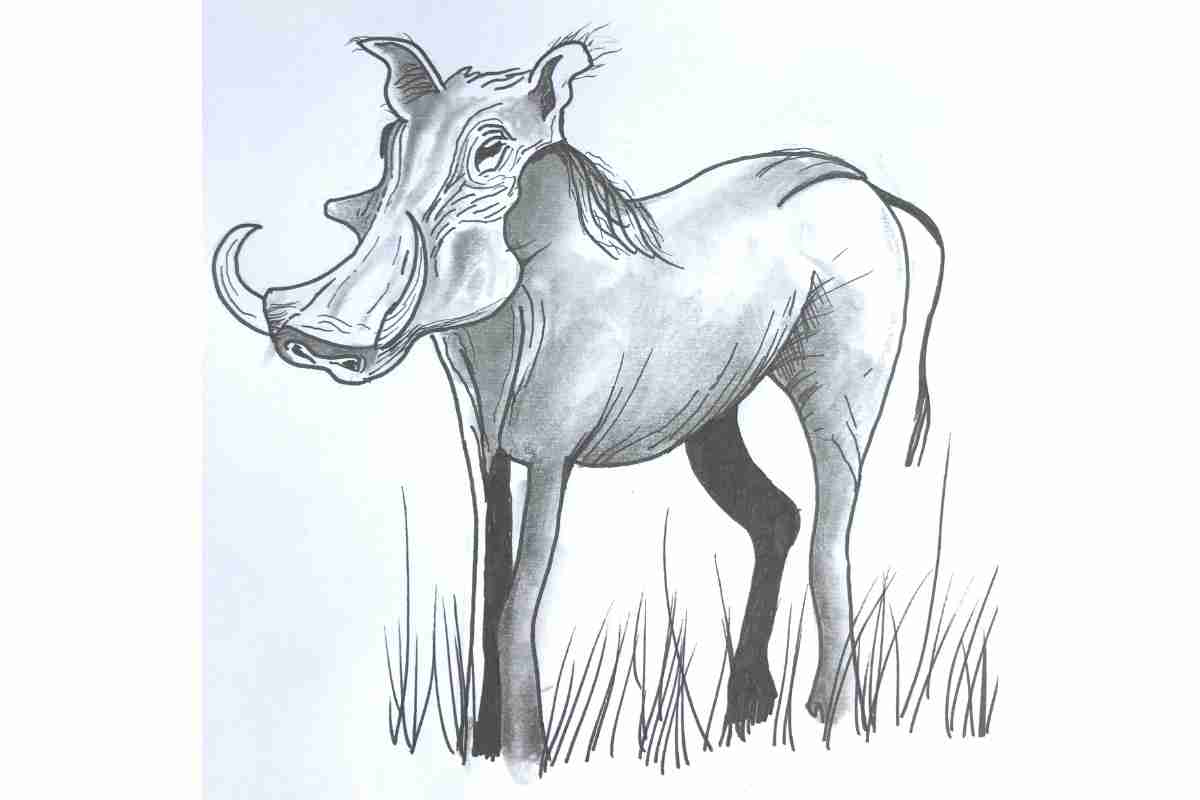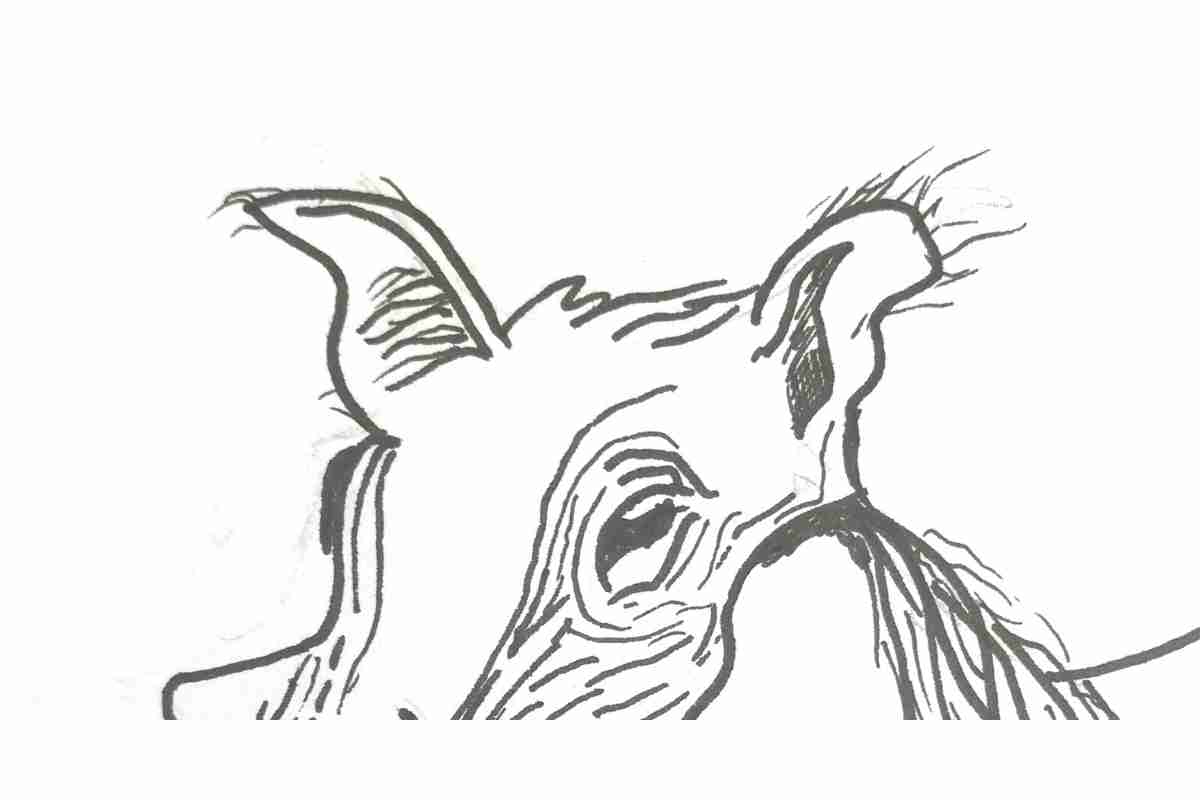Draw A Warthog Step By Step
When drawing a warthog, the best way to ensure a successful drawing is to use a step-by-step approach. If you try to capture the appearance of a warthog and dive right in without a plan, you’ll likely fail. Making matters worse, you’ll likely be discouraged as well.
Even if you feel confident starting out working in detail, remember that you’ll almost certainly struggle to draw an animal with the right proportions.
There’s a reason that starting each drawing with a sketch is a good idea, it’s because it works! Start with a sketch, get the general shape of the animal down, then go back and start to refine the drawing adding values and details.
That’s how you succeed at drawing anything, including a warthog.
You can find essential drawing equipment to complete this task here: Click here to view my basic equipment list.
Draw The Warthog’s Body
The first thing you need to understand about drawing a warthog is that it is a tough, muscular, and powerful animal. Warthogs in the wild are surrounded by predators. Since they aren’t known for their speed, the only defense against predators is being able to fight back.
Along with their tusks, warthogs also have thick and muscular bodies that should be a point of emphasis when you are drawing them. One easy way to break down their body is to picture a type of barrel and sketch that in place using a light touch.
Once you’ve done that, you can add the legs like short, stout columns. Then it’s a simple matter of refining the shapes until they resemble the body of a warthog.
Draw The Head

Your warthog drawing should have a focal point, and that focal point is the unique head of the animal.
A warthog is very similar to a pig regarding how the body is constructed. The head really sets this animal apart from its domesticated counterpart. Warthogs have very large flat heads covered in large bumps, where the animal gets its name.
Believe it or not, warts on a warthog aren’t actually warts. Instead, they are large deposits of fat that are a type of natural armor for the animal. Warthogs not only have to contend with predators, but they also frequently get into fights with other warthogs, which is why the bumps on their heads are so prominent.
The other prominent feature to focus on when drawing the head of a warthog is the tusks. The tusks on a warthog are the weapons that it uses in fights, and they are the main reason the animal can thrive in environments filled with deadly predators.
Draw Curved Line Tusks
Warthog tusks are long, slightly curved lines, and have a sharp point at the tip. There are also two sets of them, one prominent set and a smaller set closer to the tip of the animal’s mouth. After sketching in the tusks, spend extra time rendering them.
They should have a slightly rough texture, and adding signs of damage to them is a great way to create a more authentic-looking drawing.
Drawing Curved Lines
Warthogs also use their tusks to root in the dirt while foraging for food, so adding dirt to them is another nice touch you might want to consider.
Draw The Warthog Right and Left Ear
The ears of a warthog are triangular in shape, but that’s only a starting point. They should be drawn three-dimensionally with an indentation in the front.
It’s also not a bad idea to draw them with some damage. Jagged edges are typical on warthog ears since they live violent lives.
Little details like this can make a good drawing and help transform it into a great one.
Draw The Warthogs Legs
Warthog legs are relatively simple and are similar to the legs of other pigs. They are short, compact, and shaped like a tube.
The one area you should focus on is texture. Warthog’s legs, like the rest of its body, are rough and have a lot of wrinkles and lines on them. In many cases, they also have scarring, so you should consider adding that to your drawing.
Adding a scar to your warthog’s legs might not seem like that big of a deal, but the little details like this combine to help create a more exciting and realistic drawing.
Draw The Tail
Much like its legs, the tail on a warthog is pretty simple. It’s long, thin, and has a tuft of hair at its end. It also has coarse hair on parts of it, so make sure that you add that to ensure that your drawing accurately depicts what a warthog looks like.
Add Details
When drawing an animal like a warthog, it’s adding the details that should make you start to salivate as an artist. There’s just so much that you can do.
The skin texture is rough, and the warts are large and ugly, lacking a better descriptive term. There are scars to draw, bits of hair, and a lot you can do to add character to your warthog. Warthogs are not attractive animals, and you need to embrace this and lean into it.
You need to add all the textures and grittiness that define the animal. Your warthog should be ugly, it should be scarred, and it should look filthy.
As an artist, you should relish the opportunity to draw an animal with so much to offer. You could spend countless hours rendering textures, hairs, scars, and other minor details.
How To Draw Cool Animals
The secret to drawing cool animals is to choose the right subject and then embrace the nature of that animal. In the case of a warthog, you should embrace its toughness, its rough lifestyle, and its unique and ugly appearance.
If you try to draw a beautiful warthog, you’ll probably fail. It’s just not going to look right. Any attempts you make to create a more beautiful animal will only take away from the authentic look of the warthog.
So embrace the warthog in all of its glory, and you’ll enjoy yourself while drawing one of nature’s most unique animals.



